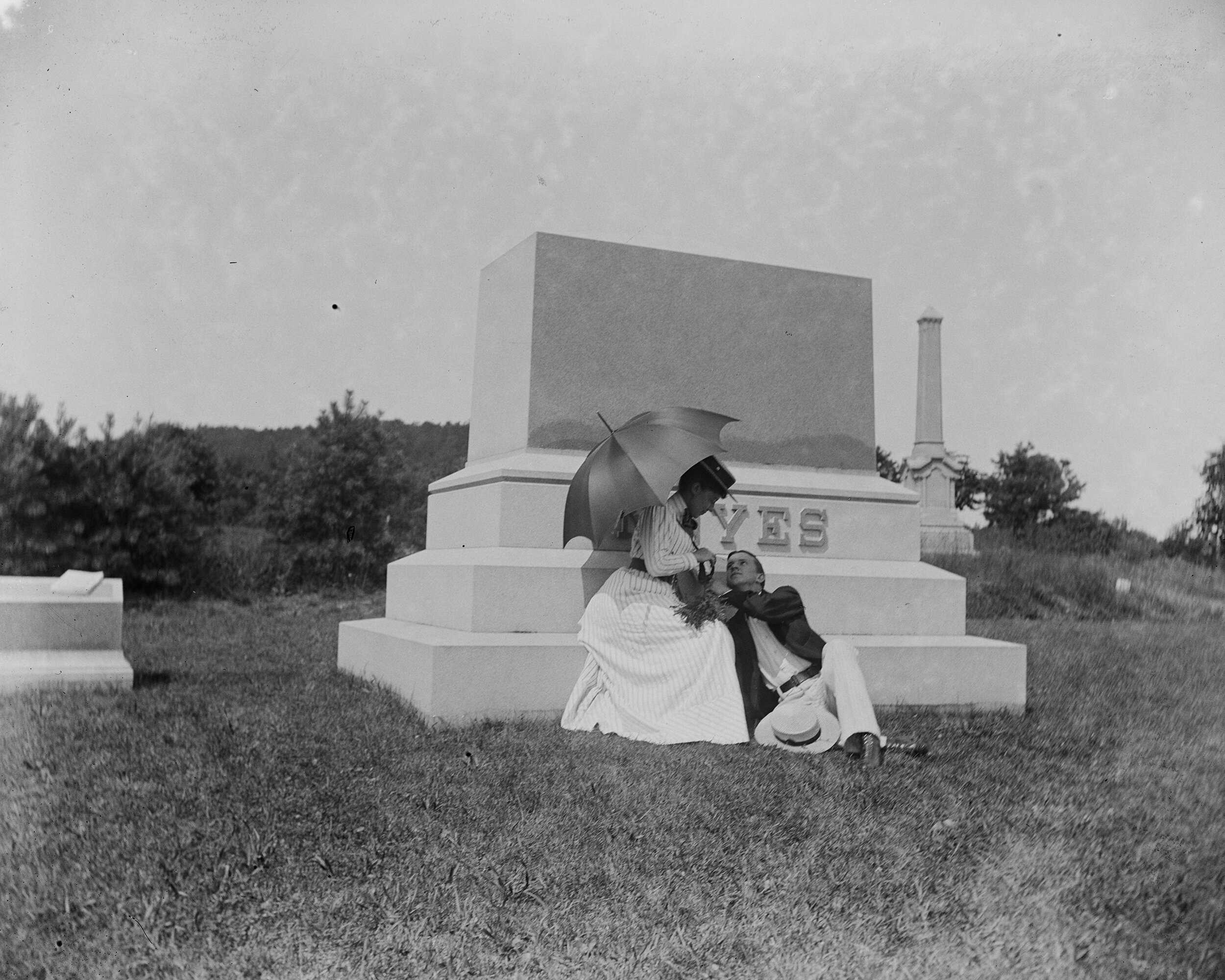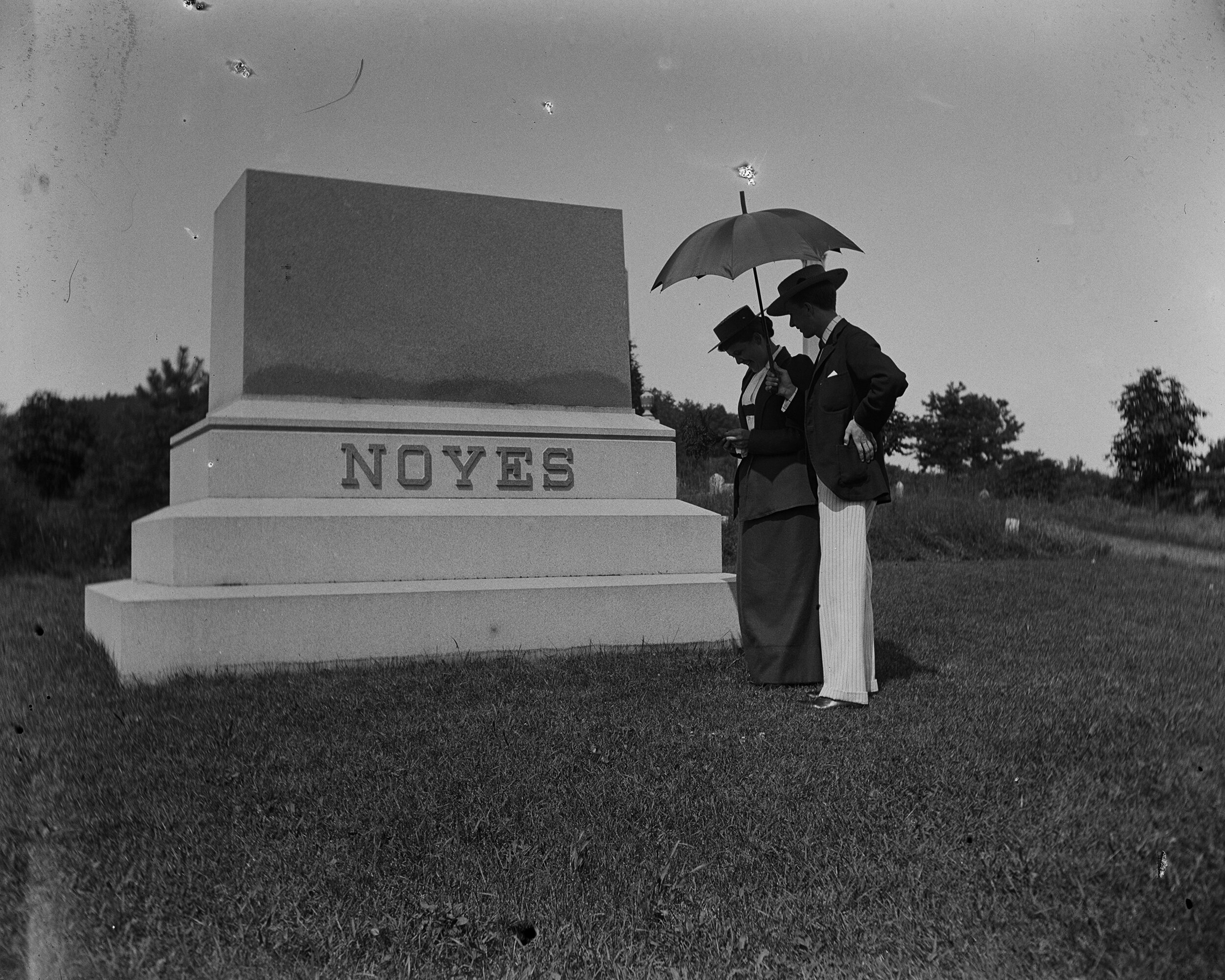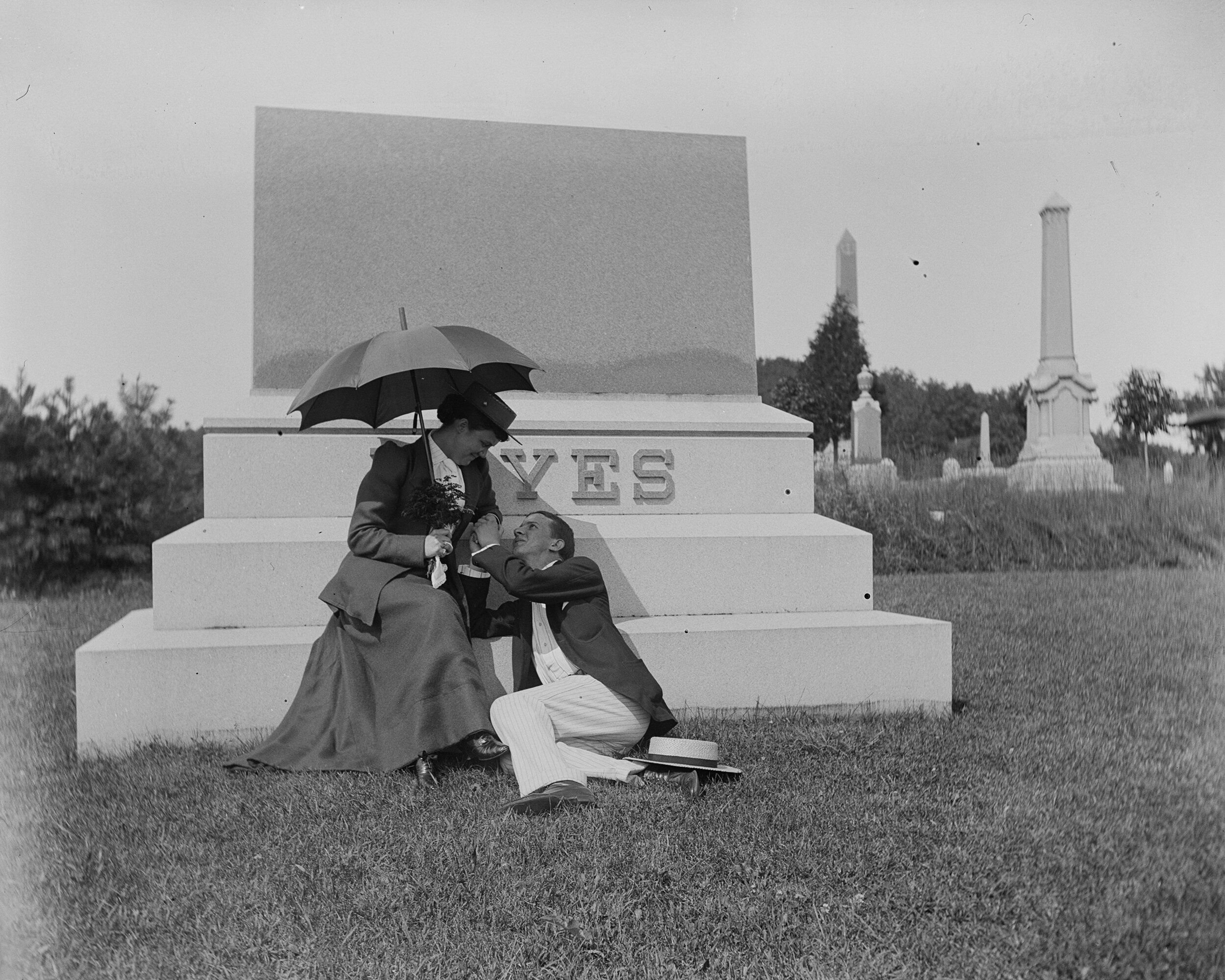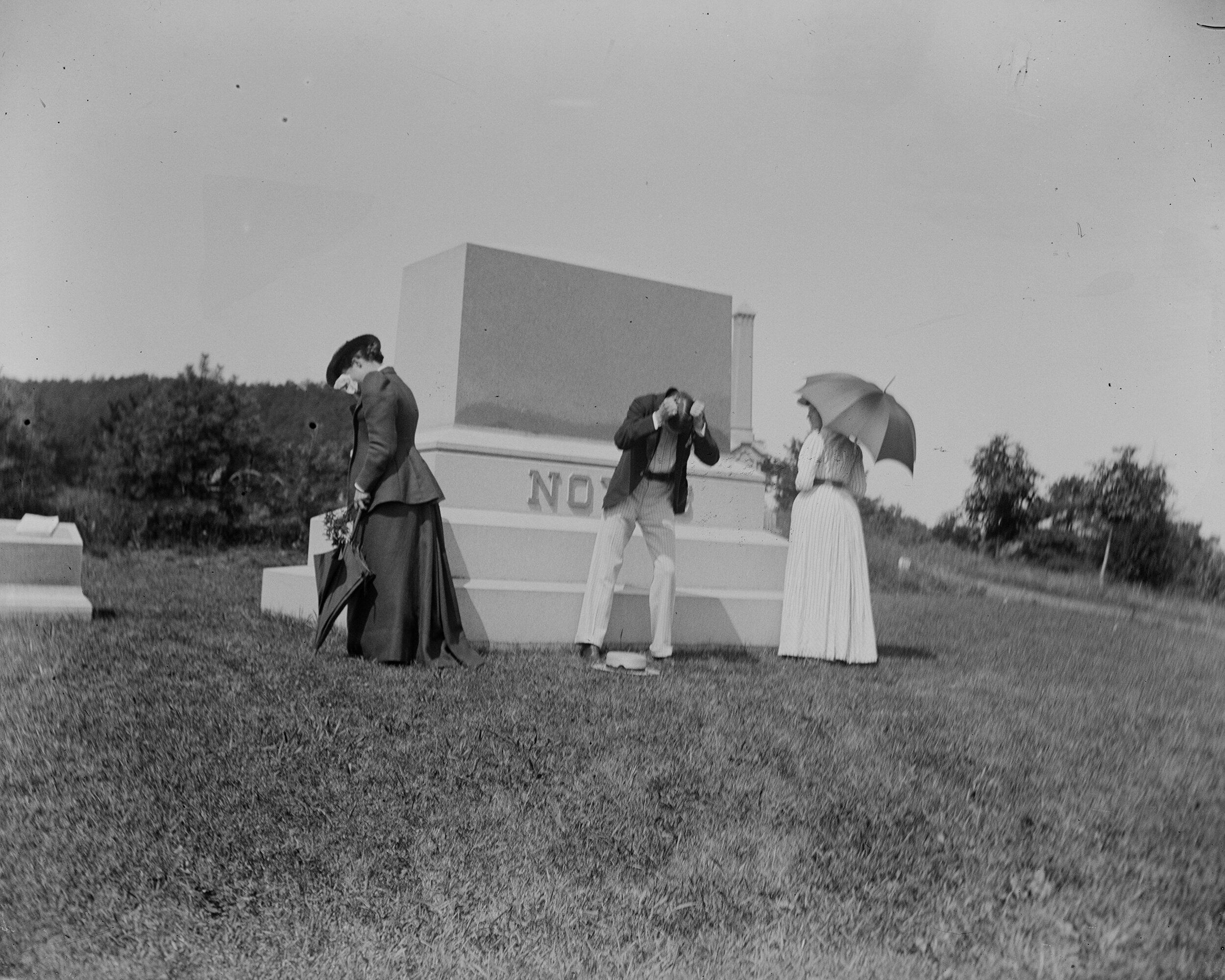Alice Austen: Travel Souvenirs
Miss Alice Austen and Staten Island’s Gilded Age
by Bonnie Yochelson
Travel Souvenirs
On her frequent visits to family and friends, Alice regularly took one or more cameras packed in a separate trunk. Despite the inconvenience of traveling with heavy, fragile equipment, she relished the opportunity to make scenic views and portraits, which she often sent to her host in lieu of a simple thank you note. Her photographs and the gossip-filled letters of her girlfriends illustrate the portability of Gilded Age upper-class life.
Group of our party, self in it, August 10, 1888. Collection of Historic Richmond Town, 50.015.6642
Alice spent two weeks in August 1888 with Trude and the Eccleston family at Lake Mahopac in Putnam County, about 50 miles north of New York City. In this sunlit group portrait, Trude and Alice sit in chairs at right. Charles Barton is holding Trude’s hand; they married twelve years later, but Trude was not interested in him at the time. In a letter to Alice, she wrote, “There is a great dearth of men up here and although every place is full of people they all seem to be old people or very young girls.”
Group on Petra, August 9, 1888. Collection of Historic Richmond Town, 50.015.6588
Alice and Trude spent a lazy afternoon with Charles Barton and Harry Wright, rowing out to Petra Island on Lake Mahopac. Alice and Harry were mixed doubles tennis partners.
[Cousin Emily, Cousin Emmie and Beauty], August 25, 1888. Collection of Historic Richmond Town, 50.015.6592
After leaving Lake Mahopac, Alice went to Fishkill to stay at Presqu’ile, the palatial home of her mother’s cousins Emily Denning Van Rensselaer and Emily’s daughter, Emmie. Alice visited them nearly every summer, usually with her mother.
Arch, Beacon Hill & part of Cottage, August 24, 1892. Collection of Historic Richmond Town, 50.015.6903
Emily and her dog Beauty are dwarfed in this magical Presqu’ile landscape. The cousins loved Alice’s photographs and ordered many copies, which they displayed at home and gave as presents. They offered her money—“set your own price”—but Alice ignored their offer. Thanking Alice, Emmie wrote, “Your beautiful work—has the double pleasure to us—of its own merit and of bringing to mind the energetic young cousin so full of purpose in this life.”
Uncle Pete’s house, June 21, 1890. Collection of Historic Richmond Town, 50.015.6962
Alice’s uncle Peter Austen lived in this imposing house on Union Street on the edge of the Rutgers New Brunswick campus. Alice’s five-year-old cousin Oswald rides a velocipede on the sidewalk; his brother William Munroe (called Munroe) and sister Elizabeth Patty (nicknamed Lysbet) sit on the front steps; and Aunt Nellie stands at a second story window. Alice visited the family at least twice a year: in June for Rutgers graduation and later in the summer at the beach in Bay Head, New Jersey.
Uncle Pete, Oswald & Lysbet, March 7, 1892. Collection of Historic Richmond Town, 50.015.5435
Nellie Miss Butler & children laughing, March 7, 1892. Collection of Historic Richmond Town, 50.015.5430
Alice took these photographs of the Austen family at home on March 7, 1892. Uncle Pete with Lysbet and Oswald pose in the front yard, and Aunt Nellie with the three children and their governess clown on the back porch.
On this trip, Uncle Pete arranged for Alice to visit some factories at her request. Alice’s mother worried about the visit, “I’m sure you must learn a great deal at the factories, but do be careful near the machinery, it always alarms me.” Trude quipped, “ If you go through all those factories & digest all you see, I am afraid we will appear very stupid to you on your return. . . “
Glen Arcade Artists dream, July 26, 1892. Collection of Historic Richmond Town, 50.015.6943
In late July1892, Alice accompanied Trude’s family to Glen Springs Sanitarium in Watkins Glen, a village near Lake Seneca in upstate New York, where Trude’s mother was scheduled for treatment. The dramatic topography, with its 400-foot-deep narrow gorge and fourteen waterfalls, made the area a popular tourist destination.
At the center of this phantasmagoric vista are Trude and her brother Sam, sitting on the railing of a footbridge. Alice borrowed her title, “Artists Dream,” from a small sign posted on the side of the gorge.
A lunch at the “San”, August 1, 1892. Collection of Historic Richmond Town, 50.015.6332
At the Watkins Glen hotel, Alice and Trude befriended A. Minshall Hopper (called Willie), an amateur photographer from Baltimore who explored the area with them. The two women flirted with eighteen-year-old Hopper, each in her own way. Trude tried on a bathing suit that Hopper said “fit her like a dream,” and Alice photographed herself tete-a-tete with Hopper at the sanitarium.
In the village cemetery, Alice, Trude and Hopper devised a six-part pantomime spoofing the perils of romance by using a tombstone for subtitles. In Part 1, Hopper and Alice pose as lovers strolling in the cemetery, in Part 2, Hopper proposes, and Alice says “yes”; in Part 3, Hopper woos Trude in the cemetery; in Parts 4 and 5, Hopper proposes, and Trude first says “no,” but Hopper persists, and she says “yes”; and in the final part, Hopper’s duplicity is revealed and both women spurn him.
Both Alice and Willie photographed the series, but only Alice’s version came out well. Willie encouraged her to submit the photo-story to the national humor magazine, Life, which they both enjoyed reading.



![[Cousin Emily, Cousin Emmie and Beauty], August 25, 1888. Collection of Historic Richmond Town, 50.015.6592](https://images.squarespace-cdn.com/content/v1/5d23a00f53f6300001f811bb/1630206090787-G7ZCU8ZI7OO6HAUNP4SF/50.015.6592_aa-c.jpg)











